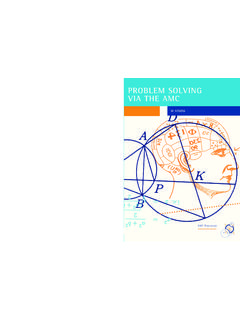Transcription of Problem Solving & Decision Making Style …
1 Problem Solving & Decision Making StyleInventory (PSI) - Self ReportName: Date of Print: Date of Assessment: Email: jon warnerWednesday, 7 November 2007 Wednesday, 7 November 2006 Worldwide Center for Organizational Development (WCOD). All rights 1jon warner - Wednesday, 7 November 2007 - PSI - self ReportPrivate and ConfidentialProblem Solving and Decision - Making StyleInventory(Perception of Self)Developed by Dr Paul Hersey, Jon Warner & Dr WalterE. NatemeyerPurposeThe purpose of this instrument is to provide feedback on your perception of your own leadershipstyle in relation to Problem Solving and Decision Making interventions. The information gathered with the Problem Solving and Decision Making Style inventory providesbroad insight into your current strengths as well as examining those areas where your skills could bedeveloped.
2 The inventory explains a range of different Problem Solving and Decision makingscenarios, and asks you to select the Style description that most closely matches how you wouldtypically respond to each of the situations. Copyright 2006 Worldwide Center for Organizational Development (WCOD). All rights 1jon warner - Wednesday, 7 November 2007 - PSI - self ReportPrivate and ConfidentialProblem Solving and Decision - Making StyleInventoryInterpreting Your ResultsThe Problem Solving and Decision Making Style inventory has been developed to evaluate theproblem Solving and Decision Making Style that you typically adopt when you are working Problem Solving and Decision Making Style ProfileThis shows the Style or styles you tend to adopt most frequently when you are trying to solveproblems or make decisions.
3 Three very important pieces of information come together to form your Problem Solving andDecision Making Style Profile:Your Primary Style : Most people have a favorite, or primary Problem Solving and decisionmaking Style . Your primary Style is the one you feel most comfortable with and therefore willhave selected most Secondary Style : Secondary, or supporting Problem Solving and Decision Making stylestend to be your backup styles when you are not using your primary Style . The column on graph1 indicating the second highest number of responses is your secondary Style . Your Style Range : Style range provides you with a sense of how flexible you are in varying thetypes of behaviors you engage in when attempting to influence people. Three or moreresponses in any one quadrant suggest a high degree of flexibility.
4 The greater your Style range,the more you are likely to be able to accommodate the needs of different followers and flex your Problem Solving and Decision Making Style or behavior accordingly. However, if your stylerange is restricted to one or two quadrants, you may find it more difficult to flex your behavior insome situations that you 2006 Worldwide Center for Organizational Development (WCOD). All rights 2jon warner - Wednesday, 7 November 2007 - PSI - self ReportPrivate and ConfidentialProblem Solving and Decision MakingInventoryjon warner's PSI Self Results Your scores from completing the on-line questionnaire are shown in the four - 7 Copyright 2006 Worldwide Center for Organizational Development (WCOD). All rights 3jon warner - Wednesday, 7 November 2007 - PSI - self ReportPrivate and ConfidentialProblem Solving and Decision - Making StyleInventoryThe Style /Readiness Adaptability MatrixDetermining Your Style Adaptability ScoreStyle Adaptability is measured on the Graph on the previous page of the Problem Solving andDecision Making Style inventory .
5 Style adaptability is the degree to which you are able to vary your Style to match the needs of afollower. Style Range shows an individual s degree of know-how of different Problem Solving anddecision Making styles , while Style Adaptability measures know-when a person s ability to usethe appropriate Style in the appropriate situation. In the Style Adaptability Graph, points are given for each alternative action selected in response tothe twelve scenarios provided in the assessment. The number of points awarded is determined byhow well the alternative action selected matches the situation. A 3 response indicates the best fit ,while a 0 response indicates that the selected action has a very low probability of use of a point system allows your Style Adaptability to be expressed as a score which allowssome generalizations to be made based on numerical benchmarks.
6 The possible adaptability scoreranges from 0 to Style /Adaptability score is _____7 Scores in this range indicate an individual with a high degree of adaptability. The personaccurately diagnoses the needs of different followers or their needs in different situationsand makes the necessary adjustments in terms of Problem Solving and Decision makingstyle in this range reflect a moderate degree of adaptability. This score usually indicatesa pronounced primary Problem Solving and Decision Making Style with less flexibility in thesecondary scores less than 23 usually indicate a need for self development to improveboth the ability to diagnose follower needs and to use appropriate Problem Solving anddecision Making communication behaviors and alternative or better matched styles indifferent scenarios. 30-36 HIGH24-29 MEDIUM0-23 LOWC opyright 2006 Worldwide Center for Organizational Development (WCOD).
7 All rights 4jon warner - Wednesday, 7 November 2007 - PSI - self ReportPrivate and ConfidentialProblem Solving and Decision MakingModelFrom your carbon response sheet, transfer your graph 1 and graph 2 scores from the 1, 2, 3 and 4boxes into the model 2006 Worldwide Center for Organizational Development (WCOD). All rights 5jon warner - Wednesday, 7 November 2007 - PSI - self ReportPrivate and ConfidentialInterpreting Your ResultsDetermining or Assessing Follower or Group ReadinessYour success in intervening in or helping a group with its Problem Solving and Decision makingefforts depends, to a large extent, on the meaning or interpretation that your followers place on thecommunication messages you send . To maximize your potential for successful communication, it isimportant to identify the factors that will influence and affect the follower s or the group s ability tounderstand, interpret and respond to the information that you communicate, or the questions thatyou communication exchanges in Problem Solving or Decision Making situations require thatyou:1.
8 Identify the specific problems to be tackled or discussed or Decision to be made2. Identify the specific problems to be tackled or discussed or Decision to be made3. Identify the specific problems to be tackled or discussed or Decision to be madeIn this model there are four levels of readiness. These readiness levels are identified in the diagrambelow:Readiness within the model can be determined by assessing two key factors:1. The level of Knowledge an individual has about the Problem to be tackled or Decision to be made2. The level of Interest an individual has in the Problem to be tackled or Decision to be madeYour role as a leader is to assess the follower or group s knowledge and interest (each time theyinitiate a particular discussion) and adjust your communication Style in order to achieve the bestresults. The Style of communication you adopt for a given exchange Authoritative, Consultative, Facilitativeor Delegative depends upon your assessment of the readiness of the person or the group you arecommunicating s useful to note that while the first two readiness levels ( in need of guidance and in need ofexplanation ) are leader directed , led by the leader given the nature and content of thecommunication, the other two readiness levels ( in need of support and in need of confirmation )are likely to be follower directed , led by the follower/s in terms of what they want or need fromthe communication.
9 Copyright 2006 Worldwide Center for Organizational Development (WCOD). All rights 6jon warner - Wednesday, 7 November 2007 - PSI - self ReportPrivate and ConfidentialThe two receiver readiness scales are:KnowledgeWhen you analyze a follower or group s knowledge of a topic you could consider influencing factorssuch as: Experience past practice Expertise current practice Education learning (past or current)It s good to remember that one or more of these factors may still render a person relatively low inknowledge related to a particular subject. For example, if you studied engineering 30 years ago buthave not applied or studied it since then, you probably wouldn t have an adequate level ofknowledge to engage in a sophisticated, hi-tech engineering Problem analysis you attempt to analyze a person s knowledge, be specific about the subject, topic or issue tobe considered.
10 Try to avoid talking down to the person, or talking over their head as in either case,you risk limiting your communication you analyze another person s interest in a topic you may consider influencing factors like: Engagement with the topic motivation or need for engaging in discussion, nonverbal and verbal expressions that indicate connection or disconnection Enthusiasm or excitement with the topic at hand Expectations do they know that they need the information, or do they anticipate a discussion about the topic will be difficult, boring, relevant, stimulating, challenging, confusing, awkwardA person s readiness level is not necessarily good or bad , it just is . When you correctly identifythe readiness level of others, you are able to more effectively communicate by considering the otherparty s knowledge of and interest in the topic at hand.








